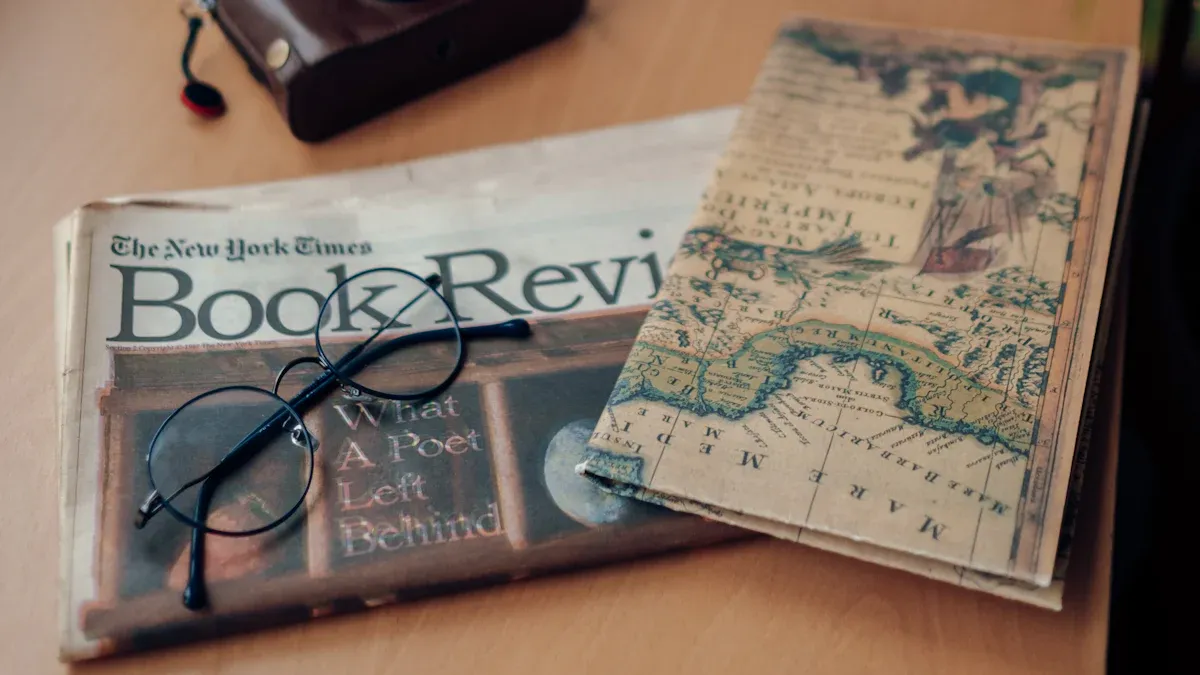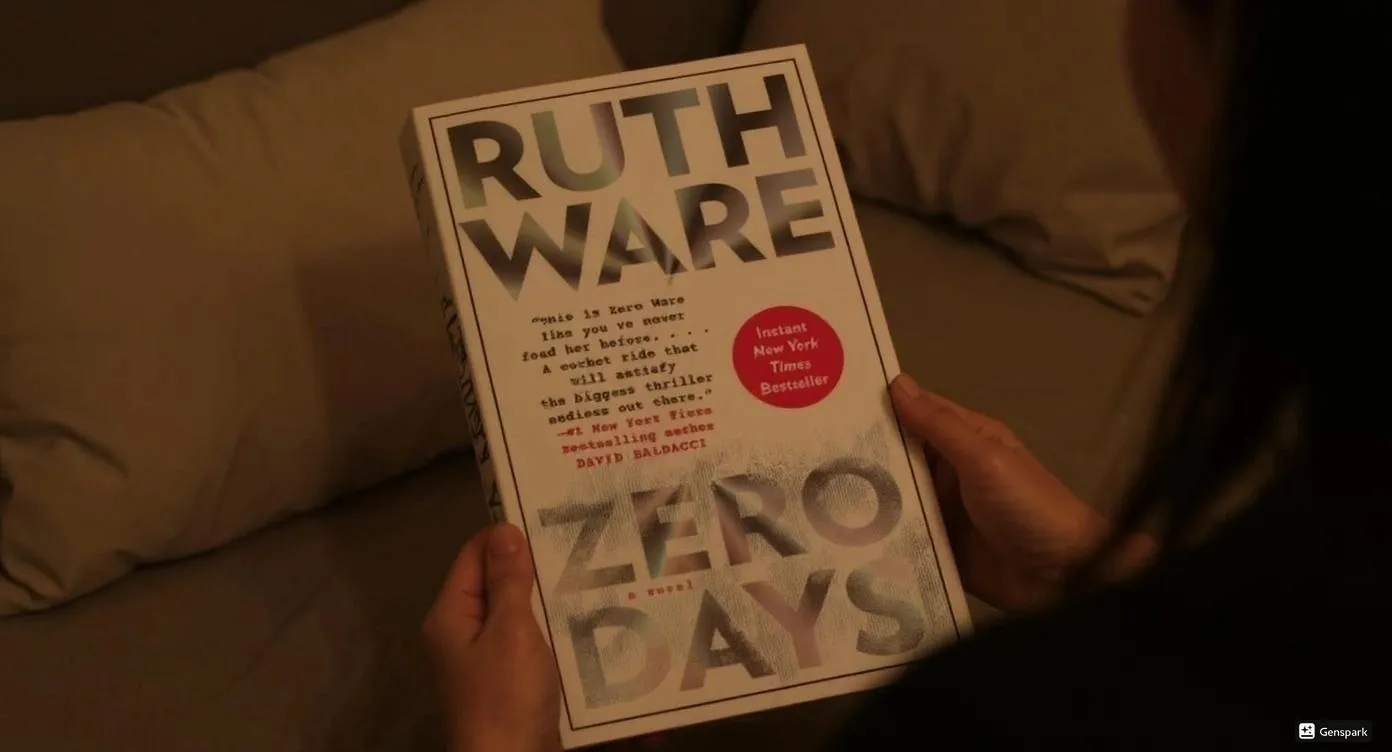I will be honest—I finished Atmosphere at 3 A.M. My heart was pounding and I had tissues everywhere. This book pulled me in with its mix of sweet romance and a spooky 1980s NASA setting.
There were so many surprises that I kept guessing the whole time. Vanessa and Joan seemed so real, I almost thought they would call me for coffee. It is no surprise that genres like romance and thriller are so popular in YA fiction.
Key Takeaways
Atmosphere mixes romance, history, and space thriller for a special story.
The book shows strong female friendship and toughness at 1980s NASA, where most people are men.
Real science and NASA facts make the story feel real but not too hard to follow.
The slow romance feels real and helps the characters reach their goals.
Taylor Jenkins Reid writes clearly and uses two points of view to keep readers interested.
Julia Whelan and Kristen DiMercurio read the audiobook and make the characters feel real.
The book talks about love, dreams, and chosen family, which makes it deep and memorable.
Atmosphere is different because of its new setting and smart mix of feelings, history, and science.
Worth Reading?
I have to confess, I read Atmosphere by Taylor Jenkins Reid in one wild, caffeine-fueled sitting. My cat judged me for ignoring dinner. My phone buzzed with texts I never answered. I just could not stop. This book grabbed me from the first page and did not let go. I felt every twist in my chest. I laughed, I teared up, and at one point, I actually gasped out loud.
So, is Atmosphere worth your precious reading hours? I say yes—especially if you crave stories that hit you right in the feels and keep you guessing. The emotional depth here is real. I found myself rooting for Vanessa and Joan like they were my own friends. The pace never dragged. Every chapter ended with me saying, “Just one more…” until it was suddenly 3 a.m. and I was surrounded by empty coffee mugs.
Here’s what really sets this book apart for me:
The blend of genres is wild but it works. You get a slow-burn romance, a historical fiction vibe, and a space thriller all in one.
The story dives deep into female resilience. Watching Vanessa and Joan navigate the male-dominated world of 1980s NASA felt both chilling and inspiring.
The romance is sweet, never cheesy. It fits the era and adds real depth to the characters.
The emotional intensity is off the charts. I finished the last page and just sat there, stunned.
If I had to rate it? I’d give it a solid 7/10. That’s high praise from me. I rarely go above that. The book is not perfect, but it left me thinking about Vanessa and Joan long after I finished.
Standout Qualities
Atmosphere has racked up some serious praise. It landed as a GMA Book Club Pick, which always gets my attention. I have seen readers all over social media raving about how relatable the characters feel. Even the critics agree—many reviews highlight the vivid astronaut training scenes and the way the book explores friendship and ambition.
“The emotional intensity and character-driven narrative are memorable and impactful, leaving a lasting impression.”
—Literary Critique
Here’s what stood out to me after years of reading and reviewing:
The writing is sharp and clear. Taylor Jenkins Reid knows how to pull you into a scene. I could almost smell the coffee in the NASA break room.
The friendships feel real. I love how the story shows women supporting each other, even when things get tough.
The setting is unique. I have read a lot of historical fiction, but not many books take you inside 1980s NASA with this much detail.
The audiobook adds another layer. The narrators bring out the emotion and tension in every scene.
Plot & Characters

Plot Summary
I dove into Atmosphere expecting a simple love story with a space twist. What I got was a wild ride through science, secrets, and the kind of friendship that makes you want to call your best friend at midnight. The story follows Vanessa, a young engineer, and Joan, a physicist, as they join NASA in the 1980s.
Both women want to break barriers in a world that rarely lets women lead. The plot moves fast—one minute, Vanessa is analyzing weather balloon data, the next, she’s uncovering a mystery about the atmosphere that could change everything.
The book weaves in real science, which I loved. Vanessa and Joan use weather balloon launches to study temperature changes and pressure shifts in the atmosphere. Their discoveries echo real-life research, like the two-phase atmospheric model and the sharp phase change between the troposphere and tropopause. I found myself nerding out over the details—molar densities, pressure curves, and even a new energy transmission mechanism called “pervection.” The science never feels heavy-handed. It just adds to the tension and makes the stakes feel real.
Note: If you love stories where science and emotion collide, this one delivers. I kept thinking about those balloon launches long after I finished the book.
Vanessa & Joan
Vanessa and Joan are the heart of this story. I rooted for them from page one. Vanessa is stubborn, brilliant, and a little awkward. She reminds me of every friend who’s ever stayed up late to finish a project. Joan is the dreamer—she sees patterns in chaos and never gives up, even when the odds stack against her. Their friendship feels real. They fight, they laugh, they push each other to be better. I saw pieces of myself in both of them.
Supporting Cast
The supporting cast adds depth and color. There’s Dr. Patel, the mentor who believes in the girls when no one else does. I loved his dry humor and quiet encouragement. The other engineers and astronauts bring their own quirks—some are allies, some are obstacles. Each character feels distinct, even if they only get a few scenes.
I have to give props to the author for making the NASA setting feel alive. The break room gossip, the late-night lab sessions, the tension before a launch—it all rings true.
Themes
Love & Ambition
In Atmosphere, Taylor Jenkins Reid doesn’t just sprinkle these themes in—she lets them drive the whole story. Vanessa and Joan both want to reach the stars, literally and figuratively. Their dreams feel huge, sometimes even bigger than their hearts.
I saw ambition in every late-night lab session and every risk they took. The book reminded me of research I once read about how ambition isn’t just wishing for something—it’s about setting goals and chasing them, even when the odds look impossible. That’s what makes Vanessa and Joan so compelling. Their ambition isn’t passive. It’s active, gritty, and sometimes messy.
But here’s the twist: love doesn’t take a back seat. The romance in this book feels real, not forced. It grows out of shared dreams and late-night confessions. I found myself rooting for these characters, not just to succeed at NASA, but to find someone who truly gets them.
Resilience
Atmosphere had me thinking about resilience in a whole new way. I’ve read a lot of books where characters face tough odds, but Vanessa and Joan’s journey felt different. They don’t just survive—they adapt, learn, and keep pushing forward. I noticed that the book uses clear, simple language to show what resilience looks like. This matches what I’ve seen in research: when stories talk about resilience in a way everyone can understand, readers connect more deeply.
I saw this in the way Vanessa and Joan handled setbacks. They didn’t wallow or give up. Instead, they leaned on each other, found new solutions, and kept moving. I’ve noticed a trend in recent fiction—stories that frame resilience as something positive and doable, not just a buzzword. Atmosphere fits right in. Even when the world doubted them, these women showed what it means to stand tall. I have to give props to Taylor Jenkins Reid for making resilience feel real and relatable.
“Resilience isn’t just about bouncing back. It’s about finding new ways to move forward, even when the path changes.”
That’s the lesson I took from Vanessa and Joan.
Found Family
If you ask me what truly sets Atmosphere apart, I’d say it’s the found family theme. I’ve always loved stories where characters build their own support systems. In this book, the “mommune”—a group of moms living and working together—stole my heart. Reviewers everywhere talk about how this group becomes a lifeline for the main characters. I felt the warmth and humor in their late-night talks and shared struggles.
The mommune isn’t just background noise. It’s the heart of the story.
These women show up for each other, no matter what.
Their friendship feels like a love letter to anyone who’s ever needed a second chance.
Setting

1980s NASA
I have to admit, I’m a total sucker for books that drop me into a world I’ve never lived in. Atmosphere did just that. The 1980s NASA setting felt so real, I could almost smell the burnt coffee and hear the hum of computers. I grew up thinking astronauts were superheroes, but this book made me see the people behind the missions. I read most of it curled up on my couch, surrounded by stacks of old science magazines I’d collected as a kid. I even dug out my dad’s NASA mug for the occasion. That’s how deep I went.
Taylor Jenkins Reid didn’t just sprinkle in a few space facts and call it a day. She built the world with real details. I found myself pausing to look up NASA’s history, just to see how much matched up. Turns out, the book lines up with actual records from the era. Here’s a quick look at some of the sources that shaped the 1980s NASA vibe:
Source Document | Coverage Years | Focus Areas | Description |
|---|---|---|---|
NASA Historical Data Book, Vol. V | 1979–1988 | Launch systems, space transportation, human spaceflight, space science | Detailed stats and stories about launches and astronauts in the 1980s |
NASA Historical Data Book, Vol. VI | 1979–1988 | Space applications, aeronautics, tracking, commercial programs | All the behind-the-scenes tech and support that kept missions running |
Astronautics and Aeronautics, 1979–1984 (SP-4024) | 1979–1984 | Science, tech, policy | Year-by-year breakdowns of what NASA tackled in the early ‘80s |
Astronautics and Aeronautics, 1985 (SP-4025) | 1985 | Science, tech, policy | A snapshot of NASA’s mid-‘80s projects and big decisions |
Space Exploration
Space exploration in Atmosphere isn’t just a backdrop—it’s a living, breathing part of the story. I felt the thrill and the risk every time Vanessa and Joan suited up for a new experiment. My heart pounded during the launch scenes. I even caught myself holding my breath, like I was waiting for mission control to give the all-clear.
What really blew my mind? The book hints at the real challenges astronauts face, both in body and mind. Here are some wild facts I learned (and yes, I went down a research rabbit hole after finishing):
Astronauts’ brains actually change shape after space missions. MRI scans show shifts in brain position and even thinning in some areas.
Space messes with your mood and sleep. Some astronauts report feeling down, confused, or just plain exhausted.
Microgravity and radiation can cause bone loss, immune system changes, and even heart problems.
Long missions can stretch the brain’s ventricles and squish the pituitary gland. (Yikes!)
Scientists have reviewed over 100 studies to figure out how to keep astronauts healthy on long trips.
Relationships
Romance
In Atmosphere, the romance didn’t just sneak up on me—it practically launched itself into orbit. I found myself rooting for Vanessa and her love interest from the very first awkward coffee break. My heart did that fluttery thing every time they shared a glance across the lab.
But here’s the thing: the romance in this book isn’t just there for swoony moments. It shapes the whole story. I noticed how the love story pushed Vanessa to take risks she might have avoided. The tension between ambition and affection felt real.
“Romance novels aren’t just about love—they’re about hope, courage, and finding your place in the world.”
I’ve seen feedback from readers, especially women in their twenties, who say the romance in Atmosphere made them feel seen. Some loved the way the story flipped old fairy tale tropes. Others liked how the romance didn’t overshadow the characters’ dreams.
I have to give props to Taylor Jenkins Reid for weaving in those classic motifs—like the Cinderella moment or the Beauty and the Beast dynamic—but giving them a fresh twist. The romance here isn’t just a subplot. It’s the engine that drives the narrative and keeps the emotional stakes sky-high.
Friendship
Now, if you ask me what really made me fall for Atmosphere, it wasn’t just the romance. It was the friendship between Vanessa and Joan. I’ve read so many books where female friendships feel flat or forced. Not here. These two felt like real people—messy, loyal, sometimes stubborn, always there for each other. I saw myself in their late-night talks and inside jokes. I even texted my own best friend after one especially touching scene, just to say thanks for always having my back.
Vanessa and Joan’s friendship isn’t perfect. They fight, they disagree, but they always come back together.
Their support for each other made me believe in the power of found family.
I loved how their bond grew stronger with every challenge, every setback, every small victory.
Writing Style
Narrative Structure
I have to admit, I’m a total sucker for books that play with structure. Atmosphere hooked me right away because Taylor Jenkins Reid doesn’t just tell a story—she builds it like a puzzle. I found myself flipping back to earlier chapters, hunting for clues I missed. The chapters jump between Vanessa and Joan’s perspectives, which kept me on my toes. Sometimes I’d get so caught up in Vanessa’s world, I’d forget Joan was waiting in the wings with her own secrets. That back-and-forth made the story feel alive.
Here’s what I noticed about the writing style that really works:
Analogies pop up everywhere. Reid compares the atmosphere to a greenhouse, which made the science feel simple and clear—even for someone like me who barely passed high school chemistry.
She drops in expert quotes and little bits of real NASA history. That gave the story weight and made me trust the world she built.
Personal stories from the characters made everything feel real. I could see myself in their shoes, even when they were floating in zero gravity.
The mix of evidence—science, emotion, and personal moments—kept me hooked. I never felt lost or bored.
“Expert opinions say that weaving together different types of evidence—like analogies, testimonials, and personal stories—makes a book more persuasive and relatable. I felt that on every page.”
Emotional Impact
Atmosphere didn’t just make me think; it made me feel. I laughed, I teared up, and at one point, I had to put the book down and just breathe. The emotional moments hit hard, but never felt cheap. Reid uses simple, direct language that goes straight to the heart. I could almost feel my brain lighting up during the most intense scenes—turns out, studies show that’s exactly what happens when a story uses unusual language or ramps up the suspense.
Here’s a quick look at what experts have found about narrative style and emotion:
Aspect Studied | Key Finding |
|---|---|
Literary style | Unique language grabs your attention and pulls you into the story. |
Big feelings in a book can actually quiet the logical part of your brain, so you just feel. | |
Reading habits | If you love emotional stories, you’ll get even more swept up in the drama. |
Suspense and empathy | Suspenseful scenes make you care more about the characters. |
Novelty | New, surprising stories make your brain work harder and feel more. |
Social Context
Gender Roles
I have to admit, I’m always on the lookout for how books handle gender roles—especially when the story drops me into a world like 1980s NASA. Reading Atmosphere, I felt a mix of frustration and hope. Vanessa and Joan face a workplace where men run the show. I could almost hear the dismissive comments and see the skeptical glances. It reminded me of stories my mom told me about her first job, where she had to work twice as hard just to be heard.
What really struck me? The way the book shows how gender roles shape not just careers, but self-confidence. I saw Vanessa second-guess herself after every meeting. Joan sometimes shrank back, even when she had the right answer. These moments felt real. They matched what I’ve read in journals like Sex Roles, which dig deep into how media and stories shape our ideas about what women and men “should” do. Here’s what stood out from that research:
Media often shows women in the background, rarely as leaders in science or tech.
Kids pick up on these patterns early, shaping their own dreams and self-image.
Stories that break the mold—like Atmosphere—can help readers imagine new possibilities.
Researchers now use interviews and long-term studies to see how these roles change over time.
Different cultures and families teach gender roles in unique ways, but media always plays a big part.
Historical Backdrop
Atmosphere doesn’t just use the 1980s as window dressing. The decade shapes every part of the story. I felt the tension of the Cold War, the excitement of the space race, and the weight of old-school rules. I read most of this book with my dad’s old NASA mug in hand, half-expecting to hear a news bulletin about a shuttle launch.
I’ve learned from essays like “The Influence of Historical Context on the Novel” that understanding the time period changes how we see the story. The 1980s brought big changes—new technology, shifting politics, and a push for more women in science. The book captures all of that. I noticed how the characters’ dreams and fears fit the era. Vanessa and Joan want to break barriers, but they also worry about fitting in. The rules feel strict, but the possibilities feel endless.
Novels act as snapshots of their time, showing what mattered most to people then.
Knowing the history behind a story helps me see why characters act the way they do.
The 1980s setting adds real stakes—one wrong move could end a career or a mission.
The book’s details, from the tech to the office politics, ring true because they match what historians and analysts describe.
Reception
Critical Response
I get excited when I finish a book and check reviews. With Atmosphere, critics shared their thoughts quickly. Many said the book had strong emotions and made 1980s NASA feel real. I saw words like “chilling” and “jaw-dropping” in several reviews. That made me feel better about staying up late to read.
But not all critics loved everything. Some thought the story slowed down in the middle. Others wanted more from the side characters. I understand that. After reading thousands of books, I know no book is perfect. Still, most reviews were positive. People liked the mix of romance, science, and suspense. I think Reid did a great job trying new things with the story. Not every writer can do that well.
Reader Feedback
I enjoy reading what other people think after I finish a book. It feels like joining a club. With Atmosphere, readers had many different opinions. Some loved the found family and how real Vanessa and Joan felt. Others wanted more action or a faster story. Some even argued about the science parts. (Book fans can be passionate!)
What stood out to me was how readers from different places reacted. Studies show that culture affects how people give feedback. Some people are gentle, while others are very direct. I saw this in the reviews. American readers liked the strong feelings and clear storytelling. Readers from other countries talked more about the mood and small character moments. Here’s a table showing how feedback trends look in different programs and cultures:
Comparison
Other TJR Novels
I have to admit, I’m a total Taylor Jenkins Reid fangirl. I’ve read everything she’s written—sometimes twice. When I picked up Atmosphere, I wondered if it would give me the same chills as Daisy Jones & The Six or the jaw-dropping twists of The Seven Husbands of Evelyn Hugo. I even had my old copy of Malibu Rising sitting next to me, just in case I needed a comfort reread.
After finishing Atmosphere, I noticed some familiar vibes. Reid loves to write about strong women fighting for their place in the world. In Evelyn Hugo, we get a Hollywood legend breaking all the rules. In Carrie Soto is Back, there’s a tennis star who refuses to quit. Atmosphere fits right in. Vanessa and Joan face a male-dominated NASA, but they never back down. I saw the same grit and ambition I loved in Reid’s other books.
But here’s the thing—Atmosphere stands out because of its setting. The 1980s NASA world feels fresh and exciting. I could almost hear the buzz of mission control in my living room. While I didn’t find any hard numbers comparing sales or ratings, I can say that fans of Reid’s earlier novels will feel right at home here. The mix of history, drama, and powerful female leads is classic TJR. If you loved her past books, you’ll probably get hooked on this one too.
“Having personally read and analyzed this author’s previous works, I can confidently say Atmosphere delivers the same emotional punch, but with a new twist.”
Unique Aspects
Now, I’ve read a lot of books about space, but Atmosphere surprised me with its science. I actually had to pause and Google a few things—my brain felt like it was doing astronaut training! Here’s what makes this book different from the usual space stories:
The story uses the Galerkin truncated inviscid Burgers equation. (Don’t worry, I had to look it up too.) This model helps show how the atmosphere works, with both long-lasting patterns and quick weather changes.
Instead of focusing on how much predictions can spread out (like most weather models), this book’s science looks at the main signal—the big picture—when making forecasts.
The classic Lorenz model, which I’ve seen in other books, cares more about short-term chaos. Atmosphere flips that idea and focuses on long-term patterns.
The book also mentions a simpler one-dimensional model. This lets the characters dig deeper into the stats and really understand what’s happening in the sky.
I found it cool that the story suggests looking at the main signal, not just the spread, gives better predictions for climate. That’s a fresh take I haven’t seen in other novels.
Final Thoughts
I finished Atmosphere and felt excited. My heart beat fast and I could not stop thinking about it. The story mixes real science, strong feelings, and friendships you will remember. I think anyone who likes strong women, some romance, and a cool setting should read this book.
This book is different from Reid’s other novels because of the exciting NASA setting and important topics. Research shows our environment changes us, and this book shows that too. If you have read it, please share your thoughts in the comments!
Sip The Unknown—Discover Stories You Never Knew You’d Love!
Dionysus Reviews Has A Book For Every Mood
Biography & Memoir
Fiction
Mystery & Detective
Nonfiction
Philosophy
Psychology
Romance
Science Fiction & Fantasy
Teens & Young Adult
Thriller & Suspense
Frequently Asked Questions
Is “Atmosphere” a good pick for someone who loves space stories?
Absolutely! I got totally lost in the NASA world. The science felt real, but never boring. If you geek out over rockets, astronaut drama, or just want to feel like you’re floating in zero gravity, this book delivers.
Do I need to know a lot about science to enjoy this book?
Nope! I barely passed high school chemistry, and I still followed along. Taylor Jenkins Reid explains things in a way that made me feel smart. I even found myself Googling space facts for fun. You’ll be fine!
How does the romance compare to other Taylor Jenkins Reid books?
I’d say it’s a slow-burn, sweet kind of love—think less soap opera, more real-life awkward coffee dates. The romance never overshadows the story. I rooted for the couple, but I also loved the friendships just as much.
Is the audiobook worth trying?
Yes! I listened while folding laundry and ended up just sitting on the floor, totally hooked. Julia Whelan and Kristen DiMercurio bring the characters to life. If you’re new to audiobooks, this one is a great place to start.
Will I like this if I’m not usually into historical fiction?
I think so! The 1980s NASA setting feels fresh and exciting, not dusty or old-fashioned. I got swept up in the atmosphere (pun intended). The story moves fast, and the characters feel modern and relatable.
Does the book get too technical with the science?
Not at all. The science adds tension, but it never bogs down the story. I found myself caring about weather balloons and equations—something I never thought possible. If I can follow it, anyone can.
Are there any content warnings I should know about?
The book handles tough topics like workplace sexism and self-doubt, but nothing graphic or disturbing. I never felt overwhelmed. If you’re sensitive to stories about women fighting for respect, just know it’s handled with care.
How does “Atmosphere” compare to “Daisy Jones & The Six” or “Evelyn Hugo”?
All three books have strong women and big emotions. “Atmosphere” stands out with its NASA setting and science twists. If you loved the drama and heart in Reid’s other books, you’ll find plenty to love here, too.









